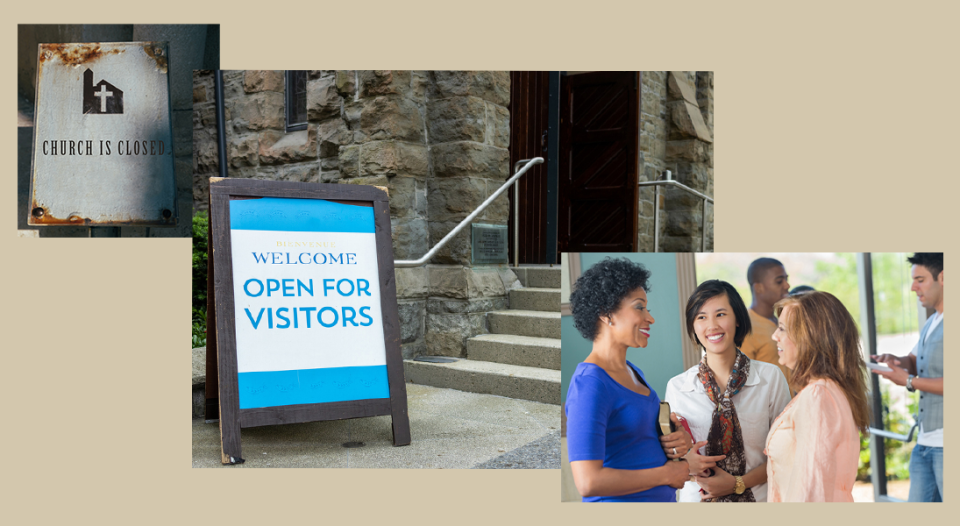“Here is the church. Here is the steeple. Open the doors and see all the people.” Many may remember acting out this rhyme by opening their thumbs and wiggling their fingers to see all the people inside. And the church was full! But for some congregations today, those wiggling fingers might only represent six people sitting in the pews on a Sunday morning.
That was the reality my congregation faced as over the years members moved away or aged and the community’s needs changed. So last year we made the painful decision to close the church doors. For the members who remained, the process of closing a church included a lot of questions, decisions and uncertainties. If your congregation is facing a similar situation, the following suggestions—based only on my experience—may help you navigate the process.
And, yes, go through the entire process. The decision to close a ministry should be made after a time of prayer, study and conversation. Closing may seem inevitable but discussing all options (merging, yoking, changing the ministry, etc.) can alleviate doubts, create consensus and prepare members for the next steps to be taken. The synod can help you walk through this discernment process.
Once the decision is made, a lot of work needs to be done by a few people. And those remaining members are dealing with a range of emotions; uncertainty about how this all works; different opinions about where assets should go, what needs to be done, who should do the work; time constraints; and family and work obligations. Be kind to each other. Hurt feelings and resentments only make a hard job harder. Talk to each other, share your concerns and explain what you’re feeling (in some cases, you may need ask your minister to help the conversations along).
The decision to close a ministry should be made after a time of prayer, study and conversation.
Like any loss, you need to take time to grieve. Whether you’re new to the congregation or a charter member, you have memories of the building, the people and the ministry. This is the place where you’ve gone for sustenance and comfort. Your church family is here. It’s OK to be sad.
But also celebrate. Rejoice in the many people your congregation has served over the years. Celebrate the ministry you’ve done in your community and the work that will continue with the help of the assets you are distributing to other ministries.
Remember, it’s an ending but also a beginning. The church is a building, but your congregation was made up of people who will find new church homes and carry on the work of sharing God’s love with others.
And when you’re ready, a nearby congregation will be ready to welcome you into their family. That was the case when First English Lutheran Church in Sharpsburg, Pa., closed in 2021. Ellen Lundie, a pastor of Bethlehem Lutheran in Glenshaw, Pa., shared a few insights her congregation learned when they welcomed members of First English. Her article in the “Wayfarer” newsletter of the Southwestern Pennsylvania Synod is excerpted here.
Honor emotions. The closure of a congregation can swiftly give way to grief as the members of the closing congregation mourn the loss of familiar services and events, cherished traditions, and the close-knit relationship cultivated within the congregation. …
Despite the pain of closure, there may be hope for new beginnings and the possibility of forging new connections in a new congregation. Leaders who are welcoming new members need to acknowledge that the closure is something that reverberates throughout the lives of those affected long after the doors have shut for the final time. Even as they find new joys and ways to get involved in the welcoming congregation, there may be moments that stir up memories or longing for what used to be. Leaders and the welcoming congregation should walk with them in times of sadness and enthusiasm.
Take a few things with you. As humans, we attach memories to places and things. While the building of a closing congregation will no longer be accessible, there may be a few items that have significance for the members that can come with them. A welcoming congregation may not need an entire supply of hymnals or every single piece of communion ware, but there are surely a few items that can find a new home. For the closing congregation, it may be difficult to think of which items they’d like to offer to the welcoming congregation. Pick one or two important things that can be a blessing to your new congregation.
By embracing newcomers with open hearts and minds, celebrating their unique gifts and contributions, and integrating them into the fabric of the church community, existing members can create a nurturing environment where all feel valued, respected and empowered to grow together in their faith journey.
The more the merrier. At the closing of a congregation, some may opt to explore different congregations individually, while others may find solace and strength in making this transition alongside fellow congregants. … When a group chooses to join a new congregation together, they bring with them the invaluable support and camaraderie of their friends in faith. … Whether navigating unfamiliar places or forging new connections within the congregation, having companions on this journey can make the transition smoother and more enriching. The journey to a new congregation becomes not just a search for a place of worship, but a reaffirmation of community and shared faith.
The welcoming congregation should prepare for members joining from the closed congregation. This may involve individuals, a committee or any group that will provide intentional welcome. This is an opportunity for compassion, empathy and unity. To ensure a smooth transition and foster a sense of belonging, your members can extend a warm embrace and provide support.
Be ready to welcome. Welcoming members reach out to newcomers, introduce themselves and express genuine interest in getting to know them. Allow new members to share their experiences from their previous congregation and their hopes in joining a new one. Listen to their stories and understand the many emotions that may be present in this change. Practical support is also invaluable. Whether it’s assisting with finding their way around the church building or connecting them with relevant ministries, existing members can demonstrate hospitality in tangible ways.
By embracing newcomers with open hearts and minds, celebrating their unique gifts and contributions, and integrating them into the fabric of the church community, existing members can create a nurturing environment where all feel valued, respected and empowered to grow together in their faith journey. As the community grows, you never know the surprises the Holy Spirit may have in store!
Read Lundie’s entire article here.





